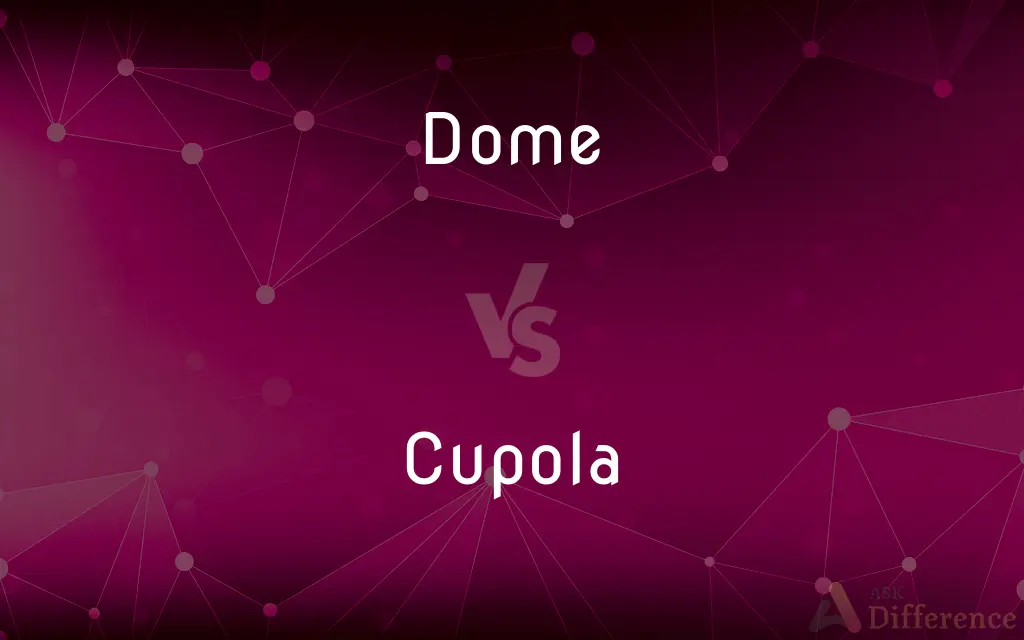Dome vs. Cupola — What's the Difference?
Edited by Tayyaba Rehman — By Maham Liaqat — Updated on March 28, 2024
A dome is a rounded vault forming the roof of a building or structure, typically circular in base, whereas a cupola is a small, often dome-like structure on top of a building.

Difference Between Dome and Cupola
Table of Contents
ADVERTISEMENT
Key Differences
Domes serve as architectural elements that cover a significant area, offering a spacious interior without the need for supporting columns, thus creating large, unobstructed spaces underneath. On the other hand, cupolas are smaller, decorative structures, usually placed on top of a larger roof or dome to add style, provide light, or enhance ventilation.
While domes are often associated with grand buildings like churches, mosques, and capitol buildings, emphasizing the vastness and importance of the space beneath, cupolas are more commonly found atop residential or smaller public buildings, acting as a visual focal point or to admit light and air.
Domes can be constructed from various materials including stone, brick, concrete, and modern synthetic materials, depending on the architectural requirements and era. Cupolas, whereas, are typically made of lighter materials like wood, fiberglass, or metal to suit their decorative and functional needs without overly burdening the structure they adorn.
The structural purpose of a dome is to distribute weight evenly across its surface, allowing for the creation of large, open spaces beneath. Cupolas, on the other hand, often serve practical functions such as housing a bell, clock, or weathervane, in addition to providing ventilation and light.
Architecturally, domes represent a significant technical achievement, showcasing advances in construction and design, whereas cupolas are seen as an element of architectural ornamentation, enhancing the aesthetic appeal and utility of a building's roofline.
ADVERTISEMENT
Comparison Chart
Definition
A rounded vault forming the roof of a building or structure.
A small, dome-like structure on top of a building.
Function
Primarily structural, creating large interior spaces.
Decorative, providing light, ventilation, or housing for bells and weathervanes.
Location
Covers a significant portion or the entirety of a building's top.
Positioned atop a roof or dome for added decoration or function.
Construction Materials
Stone, brick, concrete, synthetic materials.
Wood, fiberglass, metal, lighter materials.
Architectural Importance
Showcases technical achievement in construction.
Enhances aesthetic appeal and utility of buildings.
Compare with Definitions
Dome
A dome is a rounded vault that forms the roof of a building or structure.
The dome of the Pantheon in Rome is a marvel of ancient architecture.
Cupola
Structures that enhance the functionality of a roof by providing light and air.
The addition of a cupola improved the attic's ventilation significantly.
Dome
In many cultures, domes represent the heavens or the universe.
The dome in the mosque is often adorned with stars and patterns representing the cosmos.
Cupola
In some cases, cupolas have symbolic or ceremonial significance.
The cupola houses a weathervane that has been a symbol of the family's heritage.
Dome
Domes often symbolize grandeur and importance in architecture.
The Capitol Dome in Washington, D.C., symbolizes democracy and freedom.
Cupola
A small, dome-like structure on top of a building.
The cupola on the barn provides extra light and ventilation.
Dome
Domes come in various shapes, including spherical, onion-shaped, and saucer domes.
The onion dome of Saint Basil's Cathedral in Moscow is iconic.
Cupola
Cupolas vary in design, from simple, functional structures to elaborate ornamental features.
The custom-designed cupola was made to match the building's historic style.
Dome
A method of building that involves curving surfaces to create a spherical shape.
The construction of the dome utilized an innovative technique to support its massive weight.
Cupola
Cupolas add architectural interest and beauty to buildings.
The intricately designed cupola adds a finishing touch to the historic mansion.
Dome
A dome (from Latin: domus) is an architectural element similar to the hollow upper half of a sphere; there is significant overlap with the term cupola, which may also refer to a dome or a structure on top of a dome. The precise definition of a dome has been a matter of controversy and there are a wide variety of forms and specialized terms to describe them.
Cupola
(architecture) A dome-shaped ornamental structure located on top of a larger roof or dome.
Dome
A roof or vault having a circular, polygonal, or elliptical base and a generally hemispherical or semispherical shape.
Cupola
In architecture, a cupola is a relatively small, most often dome-like, tall structure on top of a building. Often used to provide a lookout or to admit light and air, it usually crowns a larger roof or dome.The word derives, via Italian, from lower Latin cupula (classical Latin cupella from Greek κύπελλον kupellon) 'small cup' (Latin cupa) indicating a vault resembling an upside-down cup.
Dome
A geodesic dome.
Cupola
A vaulted roof or ceiling.
Dome
A domelike structure or object.
Cupola
A small dome set on a circular or polygonal base or resting on pillars.
Dome
A system of strata that is uplifted in the center, forming a concentric anticline.
Cupola
A small structure surmounting a roof or dome, often used as a lookout or to admit light and air.
Dome
A mass of granite that has been weathered into a rounded shape by exfoliation.
Cupola
A cylindrical shaft type of blast furnace used for remelting metals, usually iron, before casting.
Dome
A mound formed by the extrusion of viscous lava from a volcano.
Cupola
A small rounded and domed structure, as for observation, on a tracked, armored vehicle.
Dome
(Chemistry) A form of crystal with two similarly inclined faces that meet at an edge parallel to the horizontal axis.
Cupola
A small turret, usually on a hatch of an armoured fighting vehicle.
Dome
(Slang) The human head.
Cupola
(geology) An upward-projecting mass of plutonic rock extending from a larger batholith.
Dome
(Archaic) A large, stately building.
Cupola
(geometry) A solid formed by joining two polygons, one (the base) with twice as many edges as the other, by an alternating band of isosceles triangles and rectangles.
Dome
To cover with or as if with a dome.
Cupola
A type of furnace used for smelting.
Dome
To shape like a dome.
Cupola
(anatomy) A small cap over a structure that is shaped like a dome or inverted cup.
The posterior cupola of the cartilaginous nasal capsule
Dome
To rise or swell into the shape of a dome.
Cupola
A small viewing window in the top of the caboose for looking over the train, or the part of the caboose where one looks through this window.
Dome
(architecture) A structural element resembling the hollow upper half of a sphere.
Geodesic dome
Cupola
A roof having a rounded form, hemispherical or nearly so; also, a ceiling having the same form. When on a large scale it is usually called dome.
Dome
(by extension) Anything shaped like an upset bowl, often used as a cover.
A cake dome
Lava dome
Cupola
A small structure standing on the top of a dome; a lantern.
Dome
(informal) A person's head.
Cupola
A furnace for melting iron or other metals in large quantity, - used chiefly in foundries and steel works.
Dome
A building; a house; an edifice.
Pleasure dome
Cupola
A revolving shot-proof turret for heavy ordnance.
Dome
(by extension) Any erection resembling the dome or cupola of a building, such as the upper part of a furnace, the vertical steam chamber on the top of a boiler, etc.
Steam dome
Cupola
The top of the spire of the cochlea of the ear.
Dome
(crystallography) A prism formed by planes parallel to a lateral axis which meet above in a horizontal edge, like the roof of a house; also, one of the planes of such a form.
Cupola
A vertical cylindrical furnace for melting iron for casting
Dome
(geology) A geological feature consisting of symmetrical anticlines that intersect where each one reaches its apex.
Cupola
A roof in the form of a dome
Dome
(transitive) To give a domed shape to.
Dome
To shoot in the head.
That guy just got domed!
Dome
To perform fellatio on.
Dome
A building; a house; an edifice; - used chiefly in poetry.
Approach the dome, the social banquet share.
Dome
A cupola formed on a large scale.
Dome
Any erection resembling the dome or cupola of a building; as the upper part of a furnace, the vertical steam chamber on the top of a boiler, etc.
Dome
A prism formed by planes parallel to a lateral axis which meet above in a horizontal edge, like the roof of a house; also, one of the planes of such a form.
Dome
Decision; judgment; opinion; a court decision.
Dome
A concave shape whose distinguishing characteristic is that the concavity faces downward
Dome
Informal terms for a human head
Dome
A stadium that has a roof
Dome
A hemispherical roof
Common Curiosities
Are cupolas always dome-shaped?
Not always; while many cupolas have a dome-like shape, they can also be square, octagonal, or other shapes.
How do cupolas differ from domes in terms of functionality?
Cupolas are primarily decorative and serve additional functions like ventilation and light, whereas domes are structural elements.
Can a dome and a cupola coexist on the same building?
Yes, a dome can serve as the main roof structure while a cupola may be added atop the dome or roof for decoration or ventilation.
What materials are commonly used in the construction of domes?
Domes are constructed from stone, brick, concrete, and various modern materials.
Why might an architect choose to include a cupola in a building design?
For aesthetic enhancement, to provide natural light and ventilation, or to house specific features like bells.
How does the construction of a dome influence its interior space?
Domes allow for large, unobstructed interior spaces by distributing weight across their curved surface.
Are domes a feature of a specific architectural style?
Domes are used in many architectural styles, including Byzantine, Renaissance, and modern architecture, among others.
Do cupolas have a practical purpose?
Yes, beyond their decorative appeal, cupolas often provide ventilation and light, and may house features like clocks or weathervanes.
What is the main purpose of a dome?
The main purpose of a dome is to cover a large space, distributing weight evenly and allowing for an open, spacious interior.
How do domes and cupolas contribute to the skyline of a city?
Domes and cupolas contribute to a city's skyline by adding unique silhouettes, enhancing the aesthetic diversity
How has the construction of domes evolved over time?
Dome construction has evolved from heavy masonry to include modern materials like steel and synthetic substances, allowing for greater spans and lighter structures.
What role do cupolas play in residential architecture?
In residential architecture, cupolas can add character, improve roof ventilation, and increase natural light.
Can the design of a dome affect a building's acoustics?
Yes, the curvature of a dome can enhance acoustics by evenly distributing sound throughout the space beneath.
Is there a size limit to how large a cupola can be?
The size of a cupola is generally limited by the structure it sits on and its intended purpose, usually remaining a relatively small feature.
What is the significance of a cupola on public buildings?
On public buildings, cupolas can signify importance, provide a lookout, or enhance the structure's aesthetic appeal.
Share Your Discovery

Previous Comparison
Sofa vs. Armchair
Next Comparison
Mean vs. SpitefulAuthor Spotlight
Written by
Maham LiaqatEdited by
Tayyaba RehmanTayyaba Rehman is a distinguished writer, currently serving as a primary contributor to askdifference.com. As a researcher in semantics and etymology, Tayyaba's passion for the complexity of languages and their distinctions has found a perfect home on the platform. Tayyaba delves into the intricacies of language, distinguishing between commonly confused words and phrases, thereby providing clarity for readers worldwide.














































